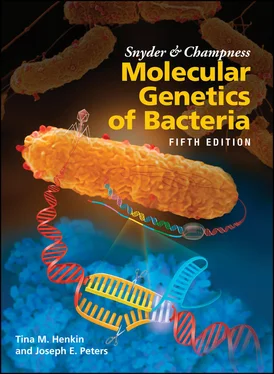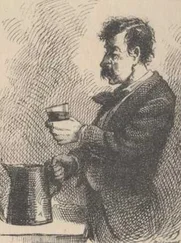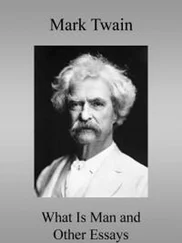During translation elongation, the ribosome moves 3 nucleotides at a time along the mRNA in the 5′-to-3′ direction, allowing tRNAs carrying amino acids (aa-tRNAs) to pair with the mRNA. Each tRNA has a specific 3-nucleotide anticodon sequence in one of its loops, and these nucleotides must be complementary to the mRNA codon for the tRNA to be bound tightly to the ribosome ( Figure 2.25). As in other nucleic acids, pairing is antiparallel, so that the two RNA sequences are complementary when read in opposite directions. In other words, the 3′-to-5′ sequence of the anticodon must be complementary to the 5′-to-3′ sequence of the codon.
Entry of aa-tRNAs bound by EF-Tu into the ribosome is random. If the anticodon is complementary to the mRNA codon at the A site ( Figure 2.23), codon-anticodon pairing stimulates a structural transition of the ribosome that promotes the next step. A mispaired tRNA is not stabilized and is released from the ribosome. This pairing of only three bases is sufficient to direct the correct tRNA to the A site on the ribosome; in fact, sometimes the pairing of only two bases is sufficient to direct the anticodon-codon interaction (see “Wobble” below). Accurate codon-anticodon pairing is monitored by specific residues in 16S rRNA that form the decoding site. The tRNA is positioned across the 30S and 50S subunits of the ribosome so that the anticodon loop is in communication with the mRNA in the 30S subunit and the acceptor end of the aa-tRNA containing the bound amino acid is in communication with the 23S rRNA in the 50S subunit. The conformational change in the ribosome that is triggered by accurate codon-anticodon pairing results in hydrolysis of the GTP on EF-Tu to GDP and release of EF-Tu–GDP from the ribosome. EF-Tu–GDP is recycled into EF-Tu–GTP by the action of another protein factor, EF-Ts ( Figure 2.23).
After the matching aa-tRNA is bound at the A site of the ribosome, the peptidyltransferasecatalyzes the formation of a peptide bond between the incoming amino acid at the A site and the growing polypeptide at the adjacent P site ( Figure 2.29). This reaction links the carboxy terminus of the growing peptide chain (attached to the P site tRNA) to the amino group of the amino acid attached to the A site tRNA. The peptidyltransferase activity is catalyzed by the 23S rRNA ribozyme.
After peptide bond formation, the P site tRNA no longer has anything attached to it, while the A site tRNA carries the polypeptide chain. Another enzyme, translation elongation factor G (EF-G), in complex with GTP, then enters the ribosome and moves (or translocates) both the polypeptide-containing tRNA and the mRNA from the A site to the P site, moving the deacylated tRNA from the P site to the E site and making room for another aa-tRNA to enter the A site. Translocation requires hydrolysis of the GTP bound to EF-G, which also results in release of EF-G from the ribosome ( Figure 2.23). The deacylated tRNA in the E site later exits the ribosome (possibly in conjunction with entry of the next aminoacyl-tRNA into the A site). The mRNA maintains contact with the tRNAs as they move through the ribosome and therefore also moves through the ribosome 3 nucleotides at a time.
The translation of even a single codon in an mRNA requires a lot of energy. First, ATP must be hydrolyzed for an aaRS to attach an amino acid to a tRNA ( Figure 2.24). Second, EF-Tu requires that a GTP be hydrolyzed to GDP before it can be released from the ribosome after each tRNA is bound, and another GTP is used for recycling of EF-Tu–GDP to EF-Tu–GTP by EF-Ts ( Figure 2.23B). Yet another GTP must be hydrolyzed to GDP for EF-G to move the tRNA with the attached polypeptide to the P site ( Figure 2.23D). In all, the energy of at least four nucleoside triphosphates is required for each step of translation.

Figure 2.29 The peptidyltransferase reaction catalyzes dissociation of the carboxyl end of the formyl-methionine from the P site tRNA fMetand peptide bond formation with the amino end of the amino acid on the A site tRNA (leucine in the diagram). This results in a P site tRNA with no amino acid and an A site tRNA containing two amino acids.
During elongation, translation proceeds along the mRNA, one codon at a time, until the ribosome encounters one of three special codons, UAA, UAG, or UGA, that serve as translational stop signals. These codons, designated termination codons, stop codons, or nonsense codons(because they do not encode an amino acid), have no corresponding tRNA (Table 2.2). When a termination codon enters the A site of a translating ribosome, translation stops because no aa-tRNA can match the codon. Similar to the positioning of translation initiation codons, the termination codon that terminates translation may not be at the 3′ end of the mRNA molecule. The region between the termination codon and the 3′ end of the mRNA (or a downstream coding sequence for another polypeptide in a transcript that encodes multiple proteins [see below]) is called the 3′ untranslated region(3′-UTR).
In addition to a termination codon, termination of translation requires release factors. These proteins recognize the termination codons in the ribosomal A site and promote the release of the polypeptide from the tRNA and the ribosome from the mRNA. In E. coli , there are two translation release factors, called RF1 and RF2, that recognize specific termination codons; RF1 responds to UAA and UAG, and RF2 responds to UAA and UGA. Another factor, called RF3, helps to release these factors from the ribosome after termination. Eukaryotes have only one release factor, which responds to all three termination codons. Some types of bacteria and mitochondria also have only one release factor, but those that do generally use UGA to encode an amino acid and not as a termination codon ( Box 2.4).
Figure 2.30outlines the process of translation termination. After translation stops at the termination codon, the A site is left unoccupied because there is no tRNA to pair with the termination codon. The release factors bind to the A site of the ribosome instead. They then cooperate with EF-G and ribosome release factor (RRF)to cleave the polypeptide chain from the tRNA and release it and the mRNA from the ribosome. An attractive model to explain how this could happen is suggested by the observation that the release factors mimic aa-tRNA ( Box 2.4). If the release factor is occupying the A site, then the peptidyltransferase might try to transfer the polypeptide chain to the release factor rather than to the amino acid on a tRNA normally occupying the A site. When EF-G then tries to translocate the release factor with the polypeptide attached to the P site, it may trigger a series of reactions that release the polypeptide. The role of ribosome release factor in this process is uncertain, but it might be involved in releasing the mRNA after termination.
REMOVAL OF THE FORMYL GROUP AND THE N-TERMINAL METHIONINE
Normally, polypeptides do not have a formyl group attached to their N termini. In fact, they usually do not even have methionine as their N-terminal amino acid. The formyl group is removed from the completed polypeptide by a special enzyme called peptide deformylase( Figure 2.31). The N-terminal methionine or entire N -formylmethionine is also often removed by an enzyme called methionine aminopeptidase, so that methionine is usually not the N-terminal amino acid in a mature polypeptide.
Читать дальше












